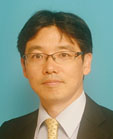Greeting

Hiroshi Kageyama, Area leader
Professor, Kyoto University
Inorganic compounds, as represented by oxides, are used in a wide variety of everyday products, such as catalysts, batteries, magnets, and electronic devices. Manufacturing, meanwhile, is critical to industrial competitiveness in Japan, which is poor in natural resources. To maintain a competitive advantage over other countries in manufacturing, it is necessary to promote the development of new materials, which are a source of competitiveness. By the end of the 20th century, an enormous number of inorganic compounds had been identified. However, since the coordination structure of the compounds, which is the basic structural unit, is limited, there have hitherto been significant restrictions on the functions that can be obtained.
Under these circumstances, as we entered the 21st century, mixed anion compounds, which contain several different anions (negatively charged ions), such as oxygen (O2–), nitrogen (N3–), and hydrogen (H–), began to draw attention. A unique local structure can be obtained from mixed anion compounds, including oxynitrides (O2–/N3–) and oxyhydrides (O2–/H–), and this suggests the possibility that fundamentally different functions may be generated in various fields.
However, there are three major hurdles in the research of such compounds. First, there are no established synthesis techniques; in most cases, oxide synthesis techniques do not work for such compounds. Second, anion analysis techniques must be significantly improved; for example, commonly used X-ray diffraction techniques cannot distinguish oxygen from nitrogen. Third, as little is known of the relationship between crystal and electronic structures and their respective functions, function prediction is not possible. In sum, in the case of mixed anion compounds, neither synthesis, analysis, or function are known, and these together are at the core of material development. Therefore, a research structure is required in which synthesis, analysis, and function are closely interrelated. However, unfortunately, the field of inorganic materials research is divided into subfields according to output, resulting in a lack of exchange between researchers.
In this new academic field, we aim to set up an all-Japan organization consisting of researchers in different fields, and to create mixed anion compounds with distinctive properties, develop anion analysis techniques, and create innovative functionality based on cooperation between the researchers. Over a five-year research term, we aim to develop a basic theory of mixed anion compounds, discover the roots of innovative chemical and physical functions, and develop such compounds into next-generation materials that will meet the needs of the future society. We/Japan will take a leadership role in the world, and will develop a worldwide research cooperation network, fostering young scientists to develop into the next generation of world-class researchers.
We believe that astonishing discoveries and surprises are awaiting us in mixed anion compound research; and we hope that both young and veteran researchers in this field (including those working on publicly solicited research), as well as students, will make innovative and curiosity-driven discoveries, by asking “Why?” and working hard together. We, on our part, will do our best to create an atmosphere in which that will happen.
